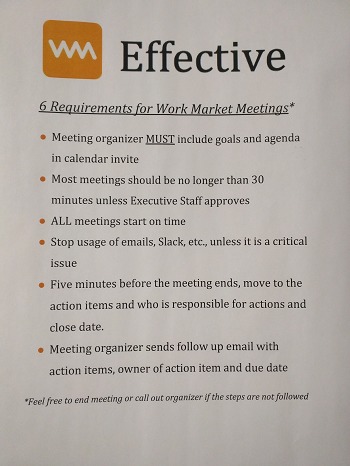The philosophy of the sales presentation and agenda is my unbound collection of all the great salespeople I have known.
Use and share any part of it and don’t attribute it to me, it is common property. I have extracted only the maxims that I think are the most luring to put in the store windows.
I was visiting with Workmarket and in their conference room was a reminder to structure internal meetings. The immediate effect should be to remind everyone that meetings have to have a purpose, a beginning, end, agreement and next steps. The residual benefit is the message is synthesized into their conduct with prospect and clients. Beyond being sound business practice its good advice and maybe makes their personal relationships a bit better also.
I wrote my extended thoughts on the presentation and agenda, but first let me start with a recap of where we have already been:
The best salespeople are selling a small bit of themselves. I wrote about my experience being top of the pack and the ‘salesperson’s annuity’, investing. Salesman Sell Something
The perfect alignment of stars is Right Person, Right Place, Right Time, I wrote about it here. Right Person. Right Place. Right Time
Cold calling is the shortest distance between two points. I extended this thought here: Cold Call or Starve. Choose Wisely
The books that are about sales are in fact about selling books about selling books. I wrote this vent here: Why I Don’t Recommend Books About Sales
When someone asks you to ‘sell me this pen’. Here’s how to do it: Passing the pen test
The best salespeople synthesize all the other ‘bests’ and stitch a philosophy together. Here’s mine: The Philosophy of the Salesperson
Begins the new. Presentation and Agenda
A (profitable, premium priced) sale to a big client is 80% meticulous preparation for the next steps in a sequence, presentation, tight agendas, commitment to a well planned implementation, letting the company be the star and allowing your role to be best supporting actor, quick responsiveness, working with the prospect to find satisfactory workarounds to complications and drawing on internal resources. The remaining 20% is your ability to fuck it up.
If the last mile of closing a deal is the salesperson then we want to improve our chances.
Lastly, if you are selling cost savings, spreadsheet wizardry and some widgets, this post isn’t for you. I can’t sell the cheap stuff, or the good stuff for cheap.
Professionally we are all sales people selling a piece of ourselves. Work is a large part of our identity, the way we see ourselves, the way we want others to see us, the way we imagine our future selves
Executives at large, ‘real’ companies hate Webex’s for complex meetings. So much of our interaction with a prospect at a large company happens in the seconds when you shake hands and look each other in the eye. Meetings on the phone is looking thru the lens of a camera. Physical meetings have intimacy and show a respect for the other side of a trade
Tele-meetings are ideal for transactions where time can be optimized. Tele-meetings surrenders advantage to the prospect
A prospect has to have a sense that you are willing to walk away from the deal. Many ‘deals’ are really just the prospect persuading the vendor to come down to their price, in that situation they hold all the leverage and you are just trying to claw some dollars back
Every communication with a prospect has to be a station on an assembly line that moves them to a close
Pitches are a performance art. Big, profitable, sales are done in a physical meeting
Send a precise, bulleted, agenda in advance of the meeting. Solicit their input to add or subtract from the agenda. Also include who will be joining you and their title. A well prepared agenda is a test you must pass. An agenda lacking exactness is directional, not precision. This means you are covertly plotting to rely on your personality and charm as a diversionary device
Wear a suit or formal business attire. This gives the presenter authority
Everyone participating on your side of the meeting should have a role that has been discussed and agreed to in advance. Someone has to take notes and make sure the meeting stays on point. Someone lese might be an expert on a particular aspect, like implementation, software or development. When appropriate, hand over the discussion to them and they must know to return control back to you
Don’t go to a meeting looking for a friend. No matter how nice the other side appears, they are not being generous in their assessment of you, they are looking for flaws and leverage. It’s part of their vender management, they are looking for tells that will also indicate if they can squeeze pricing or obtain concessions.
In advance, ask to use their projector and a meeting room
Too many people on your side of the meeting is show of force and looks bad. If it touches many different dept then the meeting can be broken into its components over several days
Before the meeting do a time check on how much time has been allotted. Get their agreement if it’s too long, too short or just right. If the meeting will run over an hour apologize for the length a promise to keep it especially tight
Projecting the demo, math or power points on a screen adds an emotional connectivity. The participants become passive and are more willing to take a less challenging role
Never (ever) sit down when giving a demo. Stand up next to the screen. If you sit down you’re too relaxed, drinking a beer and talking sports. You will wander off point. Use a remote control to your laptop for the presentation
People like visuals, the projector is a prop. The gestures you use also contribute to the messaging of your presentation. Be in control of yourself
If you must use your laptop without a projector, don’t get intimate with the prospect without first getting their permission. “May I sit with you?”
Paper handouts are like an AOL email address, don’t do it
Be tightly scripted. Be you, but no too much of you
The company you represent has to have an exaggerated presence in the meeting. Find a way to put gentle praise on it and seed with positive reinforcement
Be particularly responsive to the non decision makers. They have influence by rallying the collective forces that are not present in the meeting. Any shrugging of them will be exponentially reciprocated
Look for opportunities to say ‘I don’t know, let me get back to you with the answer’…and then do it within 24 hours
Conclude the meeting with several steps:
Ask if anything has been neglected in the discussion
Recap the agenda point for point with them, get their commitment that those items have been satisfactorily addressed
Recap their key questions to you. Re-confirm that you will have answers quickly to unresolved questions
Establish the next step in a closing sequence and get the date for action on everyone’s calendar at that time
The End?
03Jan
Philosophy of the sales presentation and agenda

